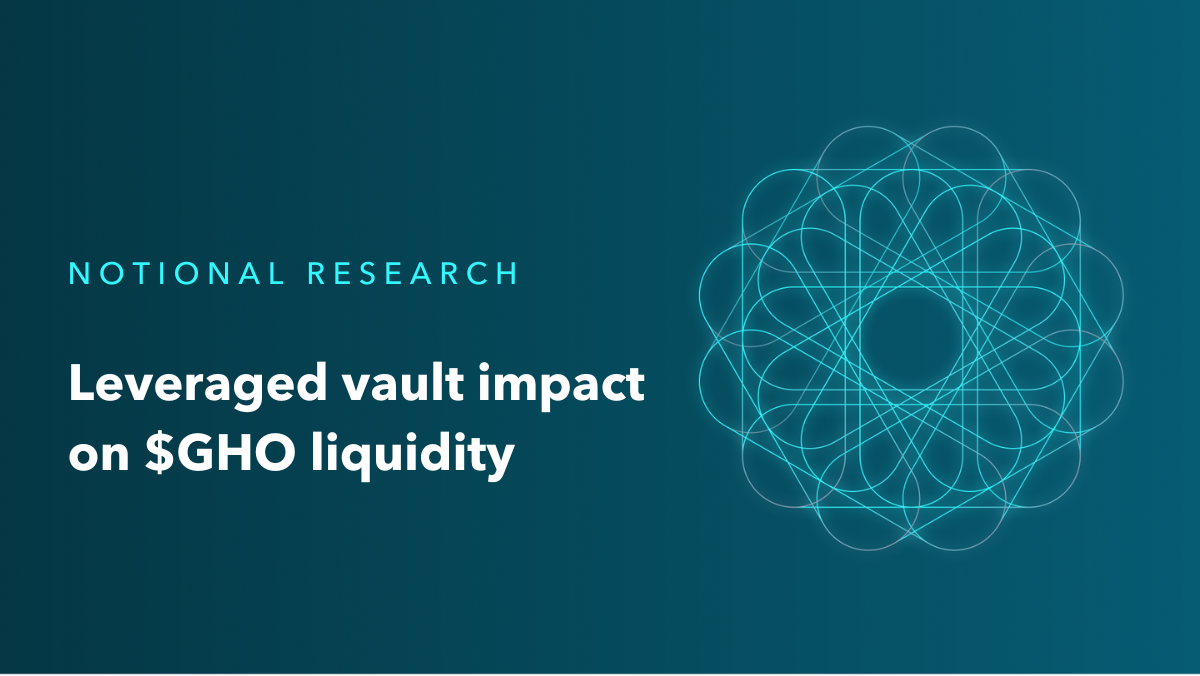
Leveraged vaults: building liquidity for $GHO
Notional received a grant from the Aave grants DAO to launch a leveraged vault that would help contribute to GHO liquidity and adoption. This product has been a significant success. Notional’s leveraged vault has contributed $1.3M in TVL to the Balancer pool (~23% of total pool TVL) and averaged ~43% of the total non-GHO liquidity in the pool since launch.
At the same time, this leveraged vault has provided substantial benefits for Notional users. This vault has enabled Notional users to earn leveraged APYs >100% APY with minimal IL and has driven significant growth in Notional's Mainnet USDC markets.
But first, let’s start with the basics.
What is a leveraged vault?
A leveraged vault is a unique Notional product that allows a user to borrow from Notional at a fixed or variable rate and deploy directly into a DeFi yield strategy that is auto-executed via smart contracts. These products give users the ability to earn very high yields if the return on the strategy exceeds the rate they pay to borrow from Notional.
Specifically, Notional launched a leverage vault that enables users to borrow USDC from Notional and deposit into a smart contract that deposits into the GHO/USDC/USDT Balancer pool. The smart contract then stakes the Balancer LP tokens on Aura to earn incentives. Periodically, the contract harvests and reinvests those incentives back into the Balancer pool to earn more incentives.Here’s a flow diagram taken from the Notional UI:
Launching the vault
Notional launched the GHO/USDC/USDT leveraged vault on Mainnet on April 2nd 2024. At the time, the Balancer pool held only $1.6M in TVL. Over the past month, the TVL in the Balancer pool increased from $1.6M to $5.6M and the TVL in Notional’s leveraged vault increased to $1.3M.
Notional’s leveraged vault has consistently contributed 20% - 25% of the Balancer Pool’s TVL over the past month and has grown to be the single largest holder of staked GHO/USDC/USDT BPTs on Aura:
This shows that the product has worked and provided a real boost to the growth of GHO liquidity on Ethereum.
USDC liquidity for GHO
Another important aspect of Notional’s leveraged vault is that all deposits it makes into the Balancer pool come in the form of 100% USDC. This means that for every 100 USDC the Notional vault deposits into the pool, it buys 33+ GHO.
This is important because the GHO/USDC/USDT pool has been consistently overweight GHO and has struggled to attract non-GHO deposits. Notional’s leveraged vault helps solve this by contributing USDC TVL.
It’s hard to judge the exact impact that this has had. We don’t know for sure to what extent this contributed to a stronger GHO peg. But we do know how the Notional vault impacted the stablecoin balances in the Balancer pool.
This graph shows the total stablecoin balance (USDC + USDT) in the Balancer pool alongside the Notional vault TVL:
Since launch, the vault has held, on average, 43% of the non-GHO TVL in the pool. This further underscores the contribution that the vault has made to total liquidity for GHO in this pool.
Benefits to Notional users
This leveraged vault has been mutually beneficial for both Aave and Notional. In exchange for contributing USDC liquidity to GHO, Notional users have been rewarded with a consistently attractive source of yield.
The exact yield that depositors into this vault earned varies depending on their leverage ratio and whether they borrowed at a fixed or variable rate. As an illustration, here is the historical APY for a Notional user who used 3.5x leverage and fixed his borrow rate at 15%:
Returns for this user have come down over time, but they still sit at 60% APY. And on average, this user has earned 126.7% APY since the vault was launched. Not bad!
Looking ahead
We see a lot more opportunity to collaborate with Aave and advance the adoption of GHO in DeFi. Here are a few of the things we’ve got planned:
- Listing GHO on Notional. GHO holders will be able to lend and borrow GHO at variable or fixed rates on Notional. They will also be able to use GHO as collateral to borrow other tokens on Notional.
- Listing GHO leveraged yield strategies. These strategies will give GHO holders the opportunity to borrow GHO and deploy into yield strategies to earn high yields, just like Notional users can borrow USDC to deploy into the GHO/USDC/USDT Balancer pool today. Some early vault prospects we’re looking at:
- Borrow GHO and deploy into the GHO/crvUSD pool on Curve. Stake the Curve LP tokens on Convex. Harvest and reinvest the CRV and CVX incentives.
- Borrow GHO and deploy into the GHO/USDe pool on Curve. Earn 20x Sats with leverage!
- Listing GHO on Arbitrum and other L2s. As GHO expands cross-chain, Notional will support GHO cross-chain. Today, Notional V3 is live on Ethereum and Arbitrum with more L2 deployments on the way. We want to grow alongside GHO on new L2s through listing the token alongside attractive GHO leveraged vault strategies.
We are excited to work with the Aave community to help push forward their vision for GHO. The best is yet to come!
Notional Finance Newsletter
Join the newsletter to receive the latest updates in your inbox.







